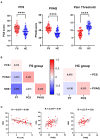Deficits in the thalamocortical pathway associated with hypersensitivity to pain in patients with frozen shoulder
- PMID: 37265462
- PMCID: PMC10229835
- DOI: 10.3389/fneur.2023.1180873
Deficits in the thalamocortical pathway associated with hypersensitivity to pain in patients with frozen shoulder
Abstract
Background and purpose: Frozen shoulder (FS) is a chronic pain condition and has been shown to be associated with pain sensitization. However, the underyling brain mechanisms remain unclear. Here, we aimed to explore brain alterations and their association with pain sensitization in patients with FS.
Materials and methods: A total of 54 FS patients and 52 healthy controls (HCs) were included in this study. Here, we applied both structural and functional magnetic resonance imaging (MRI) techniques to investigate brain abnormalities in FS patients. Voxel-wise comparisons were performed to reveal the differences in the gray matter volume (GMV) and amplitude of low-frequency fluctuation (ALFF) between FS patients and HCs. Furthermore, the region of interest (ROI) to whole-brain functional connectivity (FC) was calculated and compared between groups. Finally, Pearson's correlation coefficients were computed to reveal the association between clinical data and brain alterations.
Results: Four main findings were observed: (1) FS patients exhibited decreased thalamus GMV, which correlated with pain intensity and pain threshold; (2) relative to HCs, FS patients exhibited a higher level of ALFF within the anterior cingulate cortex (ACC) and the thalamus; (3) FS patients exhibited a significant increase in Tha-S1 FC compared to HCs; and (4) the effect of thalamus GMV on pain intensity was mediated by pain threshold in FS patients.
Conclusion: The dysfunctional thalamus might induce pain hypersensitivity, which further aggravates the pain in FS patients.
Keywords: amplitude of low frequency fluctuation; chronic pain; frozen shoulder; functional connectivity; functional magnetic resonance imaging; gray matter volume.
Copyright © 2023 Li, Li, Zhao, Zhou and Chu.
Conflict of interest statement
The authors declare that the research was conducted in the absence of any commercial or financial relationships that could be construed as a potential conflict of interest.
Figures




Similar articles
-
Brain structural and functional changes during menstrual migraine: Relationships with pain.Front Mol Neurosci. 2022 Sep 14;15:967103. doi: 10.3389/fnmol.2022.967103. eCollection 2022. Front Mol Neurosci. 2022. PMID: 36187356 Free PMC article.
-
Structural and Functional Brain Changes in Patients With Classic Trigeminal Neuralgia: A Combination of Voxel-Based Morphometry and Resting-State Functional MRI Study.Front Neurosci. 2022 Jun 29;16:930765. doi: 10.3389/fnins.2022.930765. eCollection 2022. Front Neurosci. 2022. PMID: 35844235 Free PMC article.
-
Decreased ALFF and Functional Connectivity of the Thalamus in Vestibular Migraine Patients.Brain Sci. 2023 Jan 22;13(2):183. doi: 10.3390/brainsci13020183. Brain Sci. 2023. PMID: 36831726 Free PMC article.
-
Functional and structural brain abnormalities in posttraumatic stress disorder: A multimodal meta-analysis of neuroimaging studies.J Psychiatr Res. 2022 Nov;155:153-162. doi: 10.1016/j.jpsychires.2022.08.010. Epub 2022 Aug 18. J Psychiatr Res. 2022. PMID: 36029627 Review.
-
Gray Matter Abnormalities in Patients with Complex Regional Pain Syndrome: A Systematic Review and Meta-Analysis of Voxel-Based Morphometry Studies.Brain Sci. 2022 Aug 22;12(8):1115. doi: 10.3390/brainsci12081115. Brain Sci. 2022. PMID: 36009176 Free PMC article. Review.
Cited by
-
Neuroplasticity in chronic pain: insights into diagnosis and treatment.Korean J Pain. 2025 Apr 1;38(2):89-102. doi: 10.3344/kjp.24393. Korean J Pain. 2025. PMID: 40159936 Free PMC article.
-
Neural correlates of central pain sensitization in chronic low back pain: a resting-state fMRI study.Neuroradiology. 2023 Dec;65(12):1767-1776. doi: 10.1007/s00234-023-03237-3. Epub 2023 Oct 26. Neuroradiology. 2023. PMID: 37882803
-
Machine learning-based evaluation of spontaneous pain and analgesics from cellular calcium signals in the mouse primary somatosensory cortex using explainable features.Front Mol Neurosci. 2024 Feb 21;17:1356453. doi: 10.3389/fnmol.2024.1356453. eCollection 2024. Front Mol Neurosci. 2024. PMID: 38450042 Free PMC article.
-
Functional Brain Changes in Younger Population of Cervical Spondylosis Patients with Chronic Neck Pain.J Pain Res. 2024 Dec 19;17:4433-4445. doi: 10.2147/JPR.S488988. eCollection 2024. J Pain Res. 2024. PMID: 39720323 Free PMC article.
References
LinkOut - more resources
Full Text Sources

